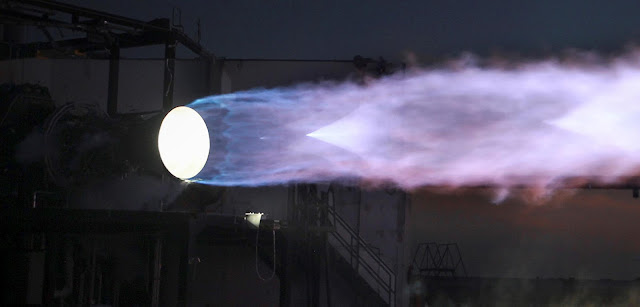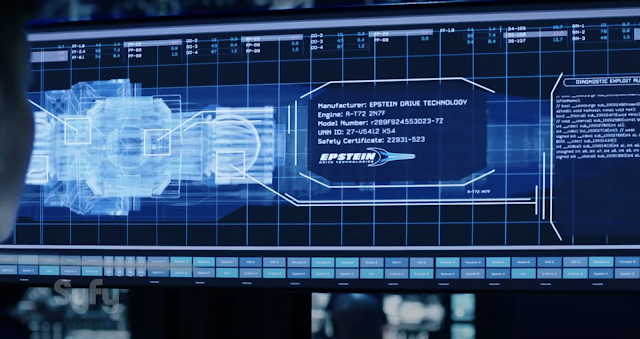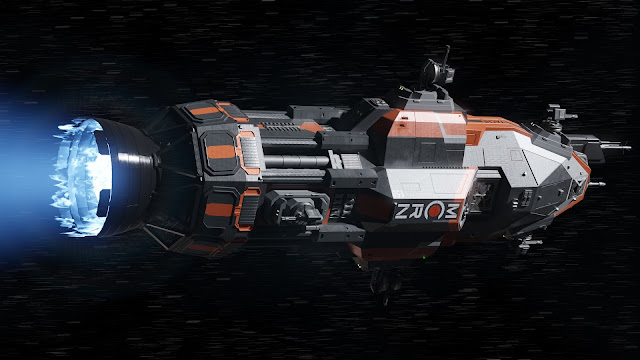“A hundred and fifty years before, when the parochial disagreements between Earth and Mars had been on the verge of war, the Belt had been a far horizon of tremendous mineral wealth beyond viable economic reach, and the outer planets had been beyond even the most unrealistic corporate dream. Then Solomon Epstein had built his little modified fusion drive, popped it on the back of his three-man yacht, and turned it on. With a good scope, you could still see his ship going at a marginal percentage of the speed of light, heading out into the big empty. The best, longest funeral in the history of mankind. Fortunately, he’d left the plans on his home computer. The Epstein Drive hadn’t given humanity the stars, but it had delivered the planets.”
- James S.A. Corey, Leviathan Wakes
_____________________________________
I gotta admit, I'm usually more of a movie fan than an ardent TV show follower. TV shows are just so much commitment, you have to keep up with each season year after year, all the while remembering all the characters and subplots going on. But when it comes to space, one series has stood above the rest for me, and that's The Expanse! The first season came out when I was a sophomore in college - I remember watching each episode in my dorm at UT Austin, feeling devastated when Syfy cancelled it after season 3, relieved when Amazon Video saved it for season 4, and now melancholy that the sixth and final season has just wrapped up. So I'd like to dedicate an Astronomical Returns post to the engine that makes the whole show possible: the futuristic Epstein drive!
The Expanse is set in a world centuries from now where humans have colonized the solar system. Earth and Mars have become independent military rivals locked in a Cold War, and both are dependent on the resources and labor of people living in the Asteroid Belt and Outer Planets. This expansion was made possible with the invention of the Epstein drive, a modified fusion rocket that uses magnetic coils to drastically accelerate reaction mass. The super-efficient Epstein drive allows spacecraft to burn for the entire length of the voyage, constantly accelerating to the halfway point before flipping around and gradually decelerating. Contrast that to our real-world propulsion systems, which expend almost all of their propellant just getting off-planet before slowly coasting to their destination!
Fun fact: when the creators of The Expanse were asked how exactly Epstein drive worked, they responded tongue-in-cheek: "It runs on efficiency"
 |
| The Epstein Drive in action on one of the spacecraft in The Expanse |
According to The Expanse's Wiki page, the Epstein drive on the Rocinante (the main characters' spacecraft) generates 6.3 million Newtons of thrust, has a specific impulse of almost 2 million seconds, and produces an exhaust velocity of 19 million m/s (6.8% the speed of light)! To ground those numbers for you:
- The F1 engine on the Saturn V first stage generated 6.7 million Newtons of thrust, but it only burned for 2.5 minutes before it was totally out of fuel; imagine accelerating with the thrust of the Saturn V engine... but basically indefinitely!
- The combustion of hydrogen and oxygen, like what the Space Shuttle burned, has a measly specific impulse of 450 seconds. And yet, this is about the theoretical maximum a chemical rocket can provide
- And for a good real-world rocket engine, exhaust is ejected at a few thousand meters per second
 |
| The Raptor engine on the test stand - in my *unbiased* opinion, the very best in rocket propulsion that humanity currently has! |
Now of course, like all good science fiction, the Epstein drive has basis in real technology. I mentioned that 1) it's a fusion rocket, and 2) it uses magnetic coils to accelerate its reaction mass
- Every rocket that has ever flown to space used a chemical engine. But that doesn't mean nuclear rockets aren't possible! In fact, way back in the 1960s, NASA successfully test fired various nuclear thermal rocket engines, which used nuclear fission from uranium to superheat liquid hydrogen and blast it out of an engine nozzle! But tragically, this promising technology got shelved when the Apollo Program ended and NASA's funding was cut. Going one step further, a rocket engine based on nuclear fusion would take a pellet of some fuel, flash-compress it with some advanced mechanism (perhaps converging lasers? Look up inertial confinement fusion) so that the atoms fuse into a superheated plasma that can be ejected out of a nozzle
- The superheated plasma is then accelerated further with electromagnetic power. Using electricity to accelerate plasma and generate thrust is not fiction - that's exactly how ion drives work, like what powered the Dawn spacecraft or SpaceX's Starlink satellites!
 |
| A screenshot of the Epstein drive schematics from the show |





No comments